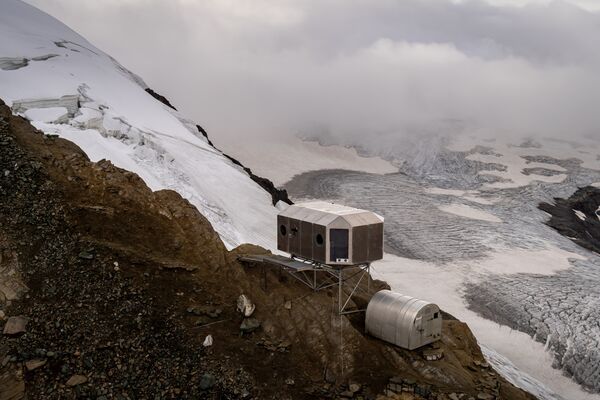A change of scenery
The Glockner bivouac once stood at 3,200 m above sea level, directly under the northern face of the Großglockner.
On Austria’s highest mountain, it offered refuge to mountaineers when their strength was failing, the night was falling or the weather was threatening to change.
On a good day, up to twelve people at a time found shelter there – was that comfortable or just necessary for survival? In this scenario, it is more valuable than a 5* hotel.
The old Glockner bivouac in its natural habitat, next to it the new generation of the bivouac, in the background the Glocknerkees glacier.

Can you imagine 12 people spending the night inside? Hardly. The bivouac requires you to be close to others; the circumstances are unique.
What makes a bivouac so special? It is common property, it belongs to everyone and at the same time to no one. This assumes that someone cares, that everyone cares. And that is what alpinists have done for 60 years. "Built in July 1958 by selfless Carinthian mountaineers," the bivouac was intended for the "use and benefit" of all mountaineers "who appreciated the Glockner north ascents". This was the case until 2020, when it fell into disrepair. Wind, weather and the extreme altitude had affected the Glockner bivouac in such a way that it needed to be replaced. So the Austrian Alpine Club decided to replace the history-steeped old bivouac with a new bivouac box.
Incidentally, bivouacs in the Alpine region stood as spartan emergency shelters long before the well-built Alpine Club huts that we now know and appreciate in many places.
We all need to take care – especially to ensure a good life in the Alps
And the Alps? They are the bivouac on a large scale, for all of us. A living space that we use, a cultural and economic space that we shape. A natural space that we must treat with care and look after together. The Alps also promise protection, recreation, and encounters. They give us a home, a place to live, to work, to relax. But what do we need to sustainably preserve and shape this space to keep it worth living in?
A shelter in the valley? The Alps symbolised by a chamber of curiosities
The bivouac comes from the mountain into the valley and becomes a symbolic shelter for the Alps. The bivouac is a transformation space where ideas can emerge and be further thought. Everything is interconnected.
- As in a hidden object picture and in nature, many things are not visible at first glance in the bivouac cabinet of curiosities. Who, for example, has found the three marmots hiding near the Alpine hut and listening to the musicians?
- Have you ever thought about what maize fields, apple orchards, lavender fields and other monocultures, hybrids and genetically modified crops do to the soil and how they affect the insects and the people who live near them?
- How does the snow grouse feel living next to a ski lodge with après ski sound?
Listen to the buzzing of bees, listen to birds chirping. Distinguish the sound of a waterfall, a spring and a stream. Call the glacier phone.
There is not one view of the Alps, not one experience, but different points of view that are shaped by our individual living conditions
What do you think is part of good life in the Alps?
Let us know by leaving a voice message
Listen to the people whose voices can be heard in the bivouac

